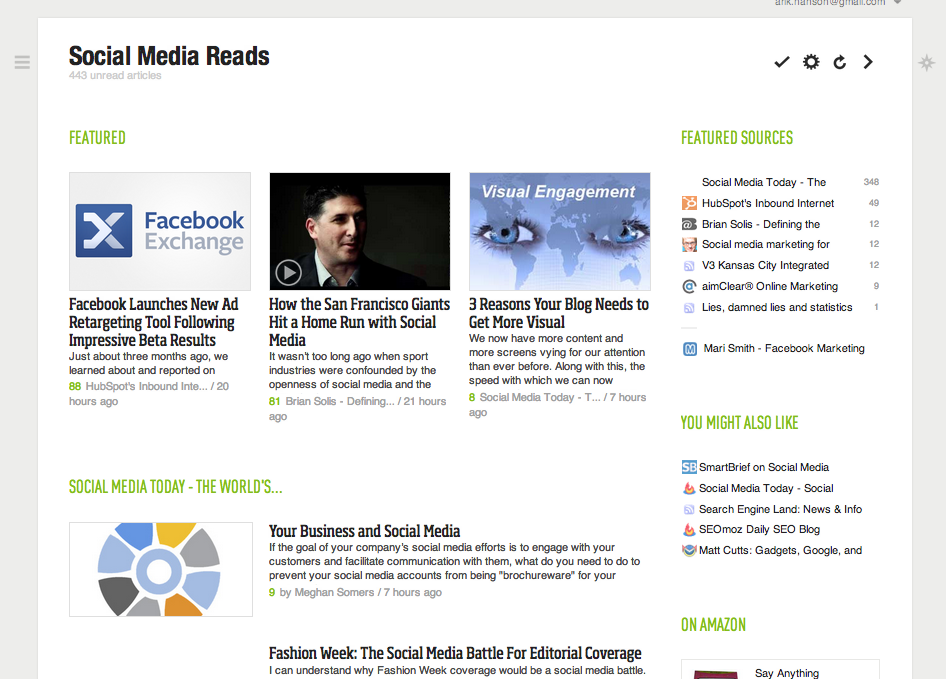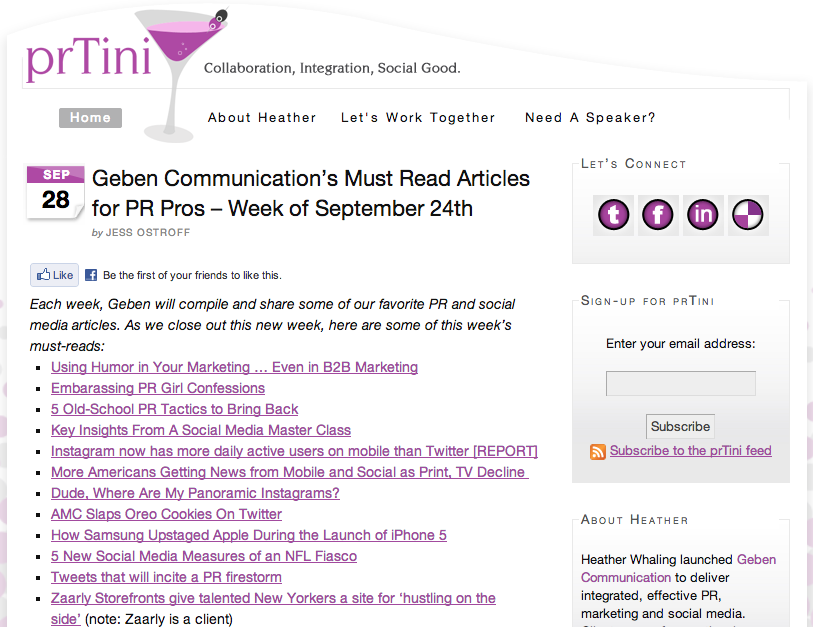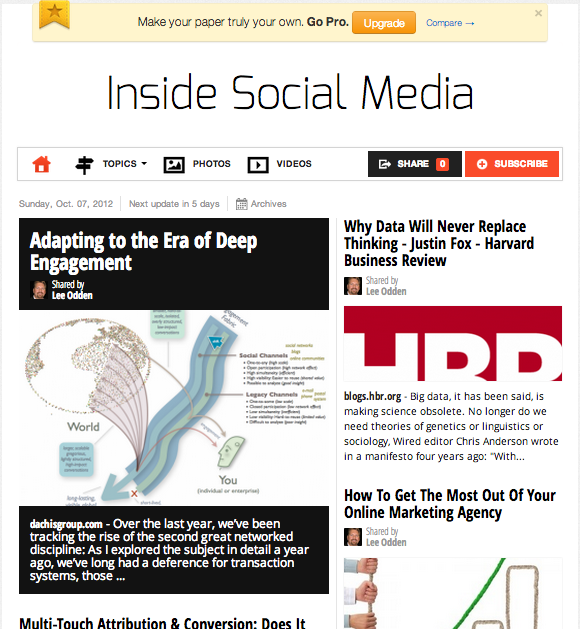Does this scenario sound familiar? You’re stuck in meetings all day. You have absolutely no time. Yet your boss is asking you to stay on top of all things social media-related. And, you need more information to do your job more effectively–and efficiently. And you want to stay smarter about industry trends.
Did I get that about right?
Yeah, I know I got it right. Because that’s the reality for me. And, if it’s a reality for me, I’m guessing it’s a reality for lots of you out there.
This is the topic I presented on at the Southern Public Relations Federation Conference in Destin, Fla., yesterday to a group of PR professionals from Florida, Mississippi, Alabama and Louisiana.
In my presentation (see the full Prezi below), I lay out 8 strategies for staying up-to-date on all the changes, new products/tools and trends in the digital world. Let’s get to it!
Strategy #1: Read 100 blogs in 15 minutes a day
I start most days by scanning my Feedly page. For the uninitiated, Feedly is a blog reader tool (much like Google Reader). I use Feedly because I like the way it’s laid out, but most folks use Google Reader. You can use either. The point is, get organized about your blog reading system. I organize my blogs by geography (MN blogs), discipline (PR, social media, mobile), clients (industry blogs) and other miscellaneous categories (fun, business blogs, etc.). With Feedly, I can scan headlines of these blogs in about 15 minutes a day (I give myself a hard stop). I look for posts that would be relevant to clients–and interesting to me. I bookmark those I think meet those criteria, maybe share them on Twitter/Facebook and move on. 100 blogs in 15 minutes. Believe it.
Strategy #2: Scan and Save
This is where a social bookmarking tool called Diigo does some serious heavy lifting for me. I use Diigo to not only archive posts (by tags/topics), but also to share them using the handy little Diigo bookmarklet on Diigo (see below).
My Diigo archive is a goldmine of articles and blog posts I’ve saved over the last 5-6 years. I use these articles and posts in presentations, client decks, blog posts and for reference in client meetings from time to time. It’s invaluable information–and it’s all at my fingertips because of this “scan and save” process I’ve developed (not all that groundbreaking, keep in mind). Other folks use tools like Instapaper and Delicious–which is fine. Everyone has tools like prefer. The point is develop a process where you can scan and save a lot of posts/articles on the Web quickly and efficiently.
Strategy #3: Maximize downtime
You know that time you waste each day standing in line for coffee, on the bus commuting or (gulp) in the bathroom (don’t lie, you know you do it)? You need to start using that time to your advantage. Use tools like Flipboard, Reeder (iPhone app) and Cadmus (great tool for catching up with what you missed on Twitter since you last signed in–see below) to keep on top of industry trends and business news. You have to maximize your downtime.
Strategy #4: Make Twitter lists your new BFF
A colleague and I lamented this point a couple months ago: Why don’t more people take advantage of Twitter lists? They give you a great way to make Twitter smaller. Consider the opportunities. Twitter lists to follow industry thought leaders. Twitter lists to follow bloggers you want to get to know better. You can even create private Twitter lists to follow competitors, industry influencers and other folks you don’t want your competitors or others seeing. What’s more, you can steal OTHER PEOPLE’S Twitter lists for you own. That’s right–why do all the work when someone else may have already done it. For example, I follow a list Lee Odden created called “MinneTweeple.” It’s a great list of interactive marketers and PR folks in the Twin Cities. Use Twitter lists to your advantage to make Twitter smaller–and more manageable–on a daily basis.
Strategy #5: Turn on the radio
Obviously I’m not talking about THE radio. That went out of style about 15 years ago, right? 🙂 I’m talking about podcasts. Again, think about your downtime. Specifically, think about the time you’re captive, where you have nothing to do but the task at hand. For me, it’s moving the lawn. I throw in the ear buds and spend 45 minutes mowing the lawn AND listening to my favorite podcast (and thus, getting smarter about my craft). My favorite? The long-running For Immediate Release, Marketing Over Coffee and Jay Baer’s new podcast, Social Pros where he interviews front-line social media folks doing REAL work. Very useful.
Strategy #6: Keep tabs on news in your industry
You know, there’s an easy way to do this. It’s called Google Alerts. Set them up for journalists, keywords, even competitors in your industry. But, I also discovered a new tool called Newsle recently (thanks Heather Whaling!) that serves you up alerts (emails) each time one of your LinkedIn, Facebook or email database contacts is featured in a news story. Might not seem like much, but this gives you a great way to keep tabs on journalists you’re trying to develop relationships with, colleagues in the industry, business partners and other influencers. All of which you want to stay connected to. Here’s an example of an email I received on a news story friend and local agency leader Blois Olson was featured in recently.
Strategy #7: Read blogs/sources that curate content weekly
One thing I learned a while ago when it comes to curating content. If someone else is doing it better than you, steal from them 😉 I shamelessly do this with my friend Heather Whaling’s blog, which curates the best posts from the previous week on her blog, PRTini. Why should I reinvent the wheel? Heather already has all the spokes in place. Or, what about Social Media Examiner’s weekly roundup? Or, what about Sarah Evans’ daily Commentz enewsletter? One of the few enewsletter I read on a regular basis. Don’t do all the work yourself–seek out those sources that already exist and use that information to your advantage.
Strategy #8: Curate your own content
Curating your own content can be just as powerful as reviewing others that have done it for you. Especially when there are tools that can do the curating for you. Like Paper.li. Many folks use Paper.li as a tool to curate content and then share that content on Twitter. I, however, use Paper.li to curate content and consume it myself. Why? Because Paper.li does all the heavy lifting–and serves me up a daily/weekly digest of posts from people Paper.li thinks I find influential/interesting. Pretty handy, right? See below for an example.
Anything you’d add? Oh, and here’s the full Prezi below:









0 Comments